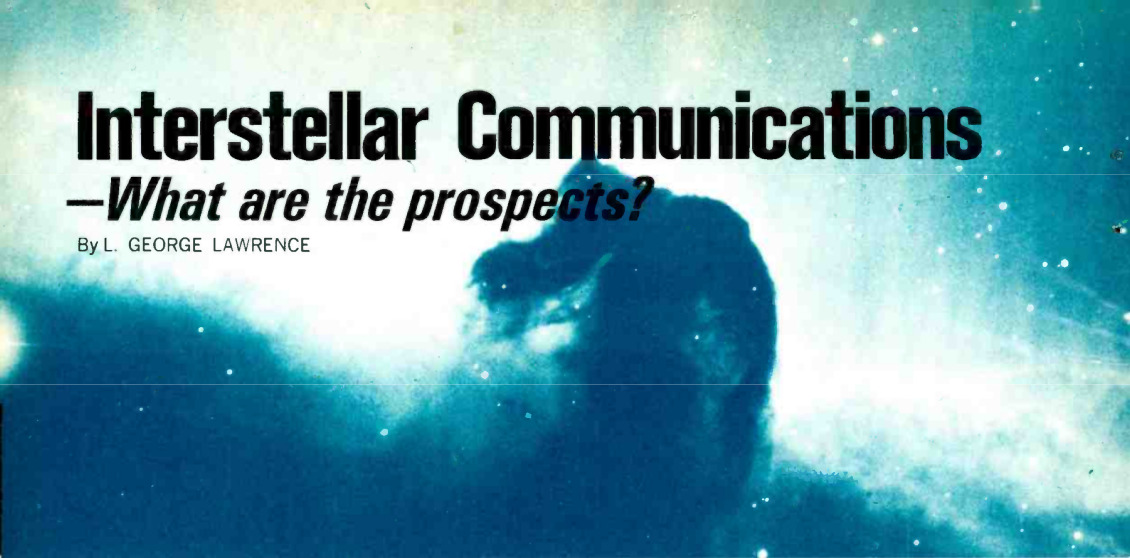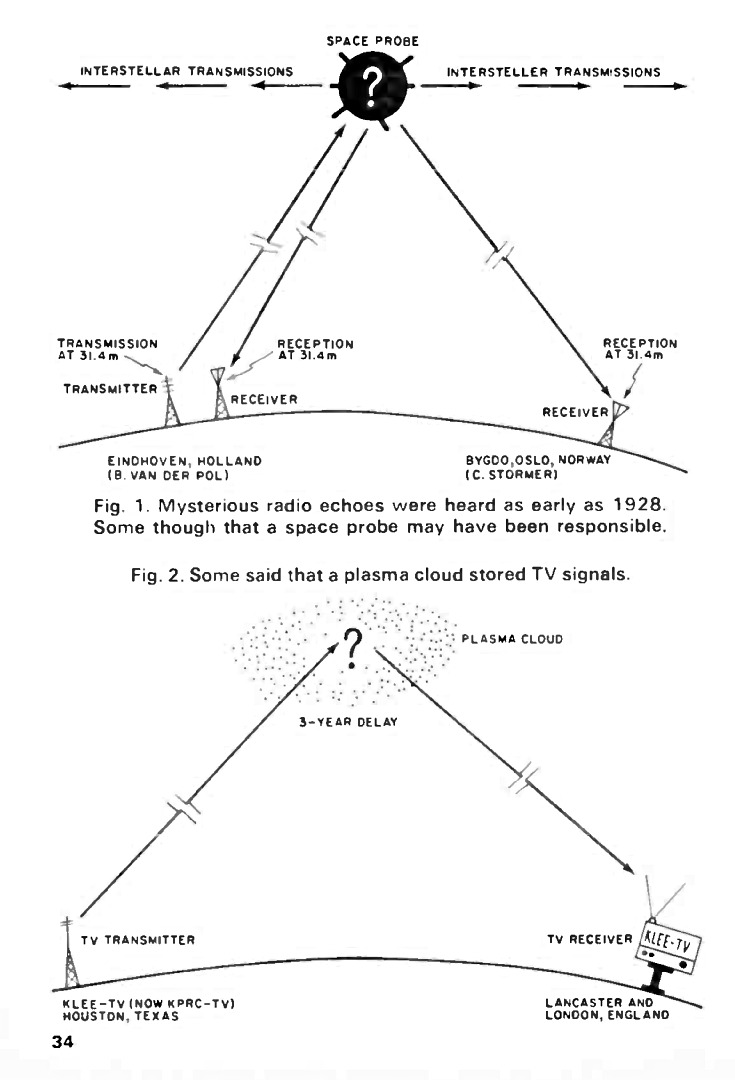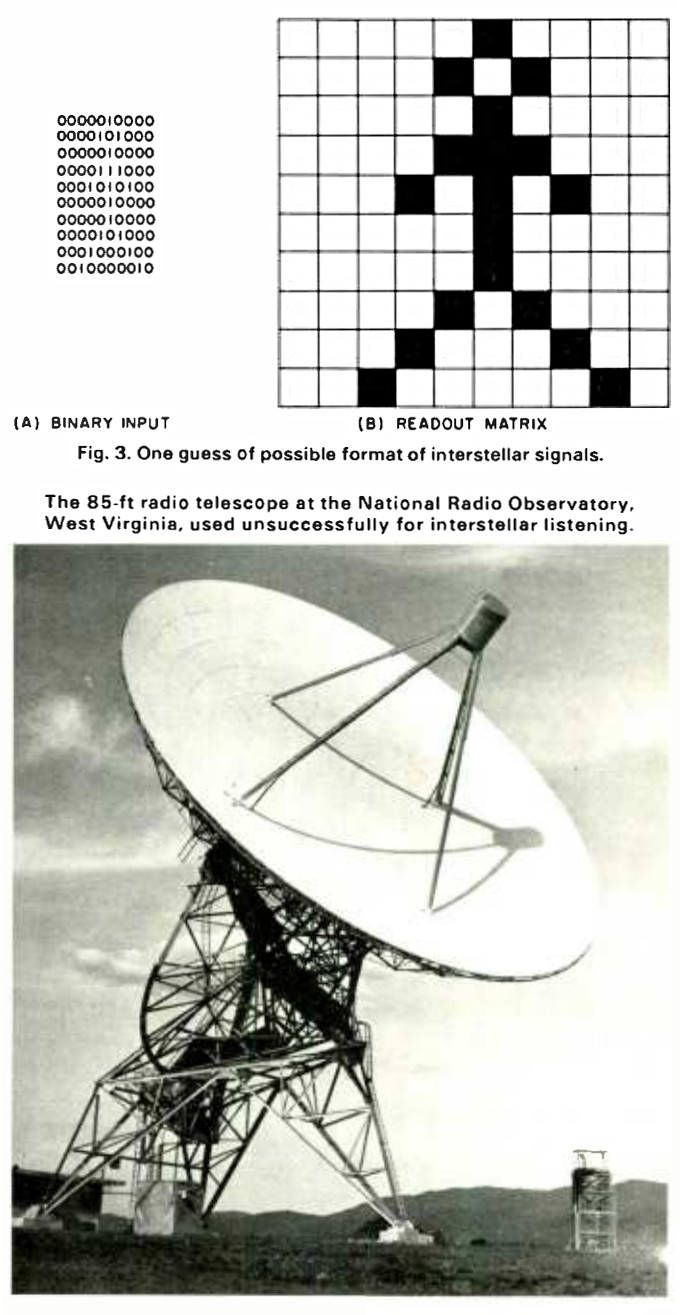
All attempts to pick up intelligent communications from the stars have failed so far. But some scientists are still wondering about intelligent beings on other worlds and our ability to contact them.
LESS than two decades ago, we still insisted that our small planet was unique in the universe. Today, on the basis of careful celestial observations and other scientific inferences, we admit that we may not be alone in the cosmic immensity and concede the possible existence of extra-terrestrial folk whose scientific development could very well be superior to our own. Some feel that good and direct benefits could be obtained by getting in touch with them. These speculations have rekindled an interest in interstellar communications technology. Principal attention is directed toward electronic aids because of the limitations of optical devices.
However, we have massive problems here and approaches are not uniform. Some scientists, for example, like to look for any non-Gaussian characteristic in signals received by radio telescopes. Others think that the natural calibration frequency of the universe, the 21-cm hydrogen line which radiates at 1.420 GHz, should be looked at more intensely. Still other investigators have suggested different approaches altogether.
Thoughts on interstellar communications have a long and continuous history. It was the modern world's first philosopher, the Greek scholar Thales of Miletus (636-546 B.C.), who proposed that the stars may be other worlds. But it was his student, Anaximander, who apparently was the first to hint that the number of worlds is infinite, some in the process of birth, some dying.
Later, in our own time, thoughts turned to means of communicating with non-terrestrials. The German mathematician Karl F. Gauss proposed that wide lanes of forest be planted in Siberia, forming a huge right-angled triangle. An Austrian astronomer, J.J. von Littrow, suggested that geometric canals be dug in the Sahara and be lit with kerosene at night. Charles Gros, a Frenchman, conceived the idea of a vast mirror to reflect sunlight toward Mars.
More realistic approaches were suggested following the discovery of radio waves. One of the early pioneers in this field, Nikola Tesla, claimed to have received signals of interstellar origin shortly after setting up his electrostatic laboratory in Colorado Springs, Colorado and equipping it with a 200-foot transmission tower.
Edison reported a somewhat similar experience. However, a massive attack, in the form of ridicule and skepticism, was made against both Edison and Tesla which reduced them to silence.
At the same time, some radio observations were made which seemed to imply (as interpreted today) that the Earth is visited by transponding communications satellites of extraterrestrial origin. These so-called "radio mysteries" were first noted in 1927 and expressed themselves as signal delays. The principal investigators attributed the phenomenon to odd behavior of the Aurora Borealis and filed it as a scientific curiosity. We will present the facts, since they form a strong argument for various hypotheses.
The Radio Mysteries
During the summer of 1927, the Norwegian radio engineer Jorgen Hals of Bygdo, Oslo was listening to the Dutch shortwave transmitting station, PCJJ at Eindhoven. At the time he heard the telegraph signals he also heard strange echoes. One was the usual echo which goes around the world with an interval of about 1/7 second, as well as a weaker echo emerging about 3 seconds after the principal echo had disappeared.
This matter was brought to the attention of Prof. Carl Stormer who, in turn, observed the phenomenon himself and then contacted Dr. van der Pol at the Philips laboratories in Eindhoven. On October 11, 1928, van der Pol and his assistant arranged to have the transmitter staff send a series of three short dots in rapid succession, sent every 30 seconds between 8:00 and 9:00 p.m. local time and comprising a total of 120 signals.
Thirteen echoes were observed, the delay times between the echoes and signals being 8, 11, 15, 8, 13, 3, 8, 8, 8, 12, 15, 13, 8, and 8 seconds. The transmissions were conducted at a wavelength of 31.4 meters; the echoes being weak, slightly blurred but plainly audible and, most important, of the same frequency.

This odd phenomenon came and went, rather than existing continuously. The echoes were again observed in 1934 during a series of tests organized by the World Radio Relay League and inaugurated by Sir Edward Appleton. This time the observers were British radio amateurs who worked the frequencies of 9.5 and 6.7 MHz. Similar echoes have also been reported by Drs. Galle, Talon, and Ferrie.
To make a scientific detective story short, it was in the early 1950's when the fact of these echoes was re-examined and that the theory of extraterrestrial-type interference was advanced. Here, as illustrated in Fig. 1, reviewers assumed the intermittent existence of an interstellar communications probe whose job it was to (a) monitor solar systems for intelligent life, and (b) re-transmit radio-frequency emanations from such life (us!) to a distant "home world." Again, the monitoring probe seemed to come and go. In 1947, 1948, and 1949, Drs. Budden and Yates attempted to observe long-delayed echoes at Cambridge, England but without success.
Critics of the interstellar transponder hypothesis became less vocal when another observation was made. This time it involved a television signal that had been delayed for over three years.
At 3:30 p.m. on September 4, 1953, C. W. Bradley of London, England, picked up on his TV set the American call letters KLEE-TV. Later that month, and various times thereafter, the same letters were observed on TV screens at Atlantic Electronics Ltd. of Lancaster, England. There is, of course, nothing unique about freakish long-distance TV reception. The strange fact is that this signal had been sent from Houston, Texas three years earlier and had never been transmitted again prior to the time it was received in England. In July, 1950 KLEE-TV became KPRC-TV and no other TV station on this planet has broadcast the call letters KLEE-TV since. (Of course, there is the possibility that some illegal or amateur broadcaster could have transmitted these call letters. — Editor)
As shown in Fig. 2, some insisted that the signal was stored, together with scanning information and correct video signals, in a "plasma cloud" which, somehow and for reasons unknown, released this data in a broadcasting mode for all to see, or perhaps it was due to the interstellar transponder postulated above.

Later Experiments
In 1959, the prospect of instellar communications via radio was supported by Drs. Cocconi and Morrison, both then at Cornell University. However, because of absorption and scattering of waves by interstellar gas clouds and nebula, plus similar attenuations by atmospheres of planets of interest, the effective range of radio-wavelengths one could use was very limited.
If, for example, wavelengths longer than 300 meters (1 MHz) were used, they would be absorbed by the inter-stellar medium. Further, since it must be assumed that given planets have ionospheres of one type or another, only wavelengths of less than 10 or 15 meters are likely to pass through and reach the planets' surfaces. After considering the effects of cosmic radio noise, things were narrowed down to wavelengths between 3 and 30 cm, finally to 21 cm or 1.420 GHz.
The reason was that Nature itself provides a fixed, "standard" calibrating frequency in the spectrum of interest to communicators: the precession frequency of hydrogen atoms. Since hydrogen is the most abundant thing in the universe, we can assume that 1.420 GHz is the fundamental frequency of Nature and known to technical interstellar societies.
Unfortunately, the 21-cm channel is a noisy one. In order to recognize data contained in such a carrier as an artificial signal, the thing to assume is that it might have a narrow-band character and would vary with time. A signal sequence might be in the form of dots and dashes, giving a binary counter-input pattern such as that shown in Fig. 3. The ones given at (A) have been expressed as dark spaces in the readout matrix (B), while the zeros are entered as light spaces.
While little more than a two-dimensional pattern, a readout of this basic type would contain an enormous amount of information. First, they use a decimal system for their purpose. Next, they are bipeds — just like ourselves. And that, in turn, would allow us to reason that there might be similar traits in behavior, thinking, and expressiveness. Further, being intelligent beings, they would not overwhelm us with complex dimensions in their communications simply because we couldn't understand them. Again, the 21-cm hydrogen line appears to be a logical choice for data transport because of its universality.
Subscribing to the 21-cm channel theory, Dr. Drake's famous "Project Ozma" used the 85-foot radio telescope at the National Radio Observatory during the months of May, June, and July, 1960 for actual listening attempts. The instrument employed two horns and a semiconductor-diode parametric amplifier as the first amplifying stage. During the entire search for intelligent signals, a bandwidth of 100 Hz was used. One of the two antenna horns received radiation from a small area near a star of interest (where one might expect to find a transmitting planet). Entering the other horn was radiation from a neighboring region of the sky. Using electronic antenna switching and synchronous detection at the receiver, a good degree of sensitivity was obtained — but, unfortunately, no results.
Today, many astronomers still share the conviction that deep-space searches for intelligent life should be concentrated on stars which are less than 15 or so light-years away from our solar system.
Interstellar Event or Mythology?
Interstellar spaceflight is technically feasible, even though it is an enormously expensive and difficult undertaking. Perhaps this has been developed to absolute perfection by extra-terrestrial societies whose worlds were old when the Earth was young. Thus, if we assume scientific developments a million or billion years ahead of our own, an altogether different approach to interstellar communications and physical commerce emerges.
Some local field investigations tie in with such and similar considerations. The objective is a geophysical definition of dated American Indian legends which imply the presence of celestial beings within or near tribal systems that have long ceased to exist. Unavoidably, stories of this kind smack of UFOistic hocus-pocus and can be considered valid only after their contents have been verified by impartial scientific methods.
The Yuman-speaking Mohaves, Cocopas, Halchidhomas, Yumas, and Maricopas, together with the Chemehuevis of the Utaztecan language family, all lived, at one time or another, along the lower Colorado River and shared certain legends of space and time. The Chemehuevis, in particular, originally came from the eastern Mohave Desert in California and it was in this approximate region that the legend of "the mountain of the bearded god" was born.
According to the story, a "humming star" came from the sky, landed in the desert near a dry lake and — as Indians watched with great fear from a respectful distance — dug in and triggered massive lava flows from what are now known as the Pisgah and Amboy craters near U.S. 66, going east. A short time later, strange men were seen after whom the mountain of the bearded god was named. This is an outrunner of the Cady Mountains and, if looked at from the spot the Indians once stood, shows a distinct forehead, a nose, and a small mouth with a massive beard.
The question is: Was a real interstellar experience witnessed by an unsophisticated people or is it mythology and nothing but?
Originally published in "Electronics World" (October 1971). Browse AmericanRadioHistory.com for complete issues of E.W. and many other historical radio and electrical publications in PDF format.
Return to the BIO-ICOMM Project homepage or the Bibliography of L. George Lawrence.
